The Hoult family’s sacrifice
- Home
- World War I Articles
- The Hoult family’s sacrifice
The WFA Pension Cards Ledger Project has identified yet another family to add to the list of those unfortunate enough to have lost five sons as a result of the Great War, albeit that three of these died after the Armistice.
Patience Mellor, formerly Patience Hoult, lost five sons who served in the Great War, two died during the war, one very shortly afterwards while still in service, and two in the early 1920s, both from disease attributed to war service.

Pre-War Family Background
Thomas and Patience Hoult had ten children between 1875 and 1897, all births being registered in the Derby district, and with mother’s maiden name recorded as Moore. Both parents were born in Leicestershire, Thomas Hoult in the village of Woodhouse Eaves around 1836, while Patience was born in Hinckley in 1853, the daughter of a brush maker from Greenwich.
Although no record of their marriage could be found, it is widely known that a small percentage of marriage records are missing from the General Register Office (GRO) indexes. Thomas and Patience are known to have been in Derby from 1875 onwards. They had four daughters, Emma Celia in 1875, Annie in 1877, Louisa in 1879, and Patience in 1883. There were also six sons, Thomas in 1881, James Arthur in 1887, Ernest in 1889, Albert in 1892, Sidney in 1894, and Walter in 1897. Thomas was recorded as a bricklayer in both the 1881 and 1891 census, with the family living respectively at 11 Grey Street and 83 Boyer Street. Various baptism records show that the family moved often, even within the same street, this being quite normal at the time.
Thomas Hoult died in 1900, aged 64, and Patience was recorded as a widow in the 1901 census, living at 23 Leman Street; her eldest son Thomas, and eldest daughter Emma, had already left home. She married John Mellor on Christmas Day 1903.

John Mellor’s death was registered in early 1911, aged 60.
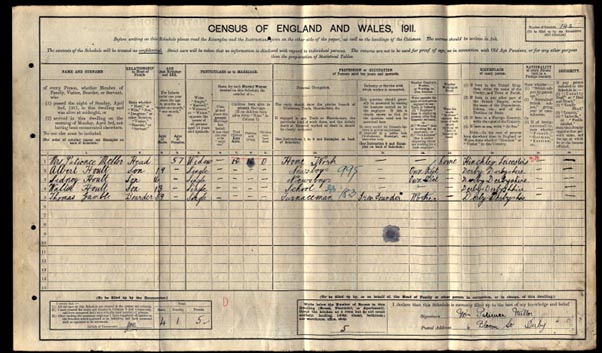
Pension Records
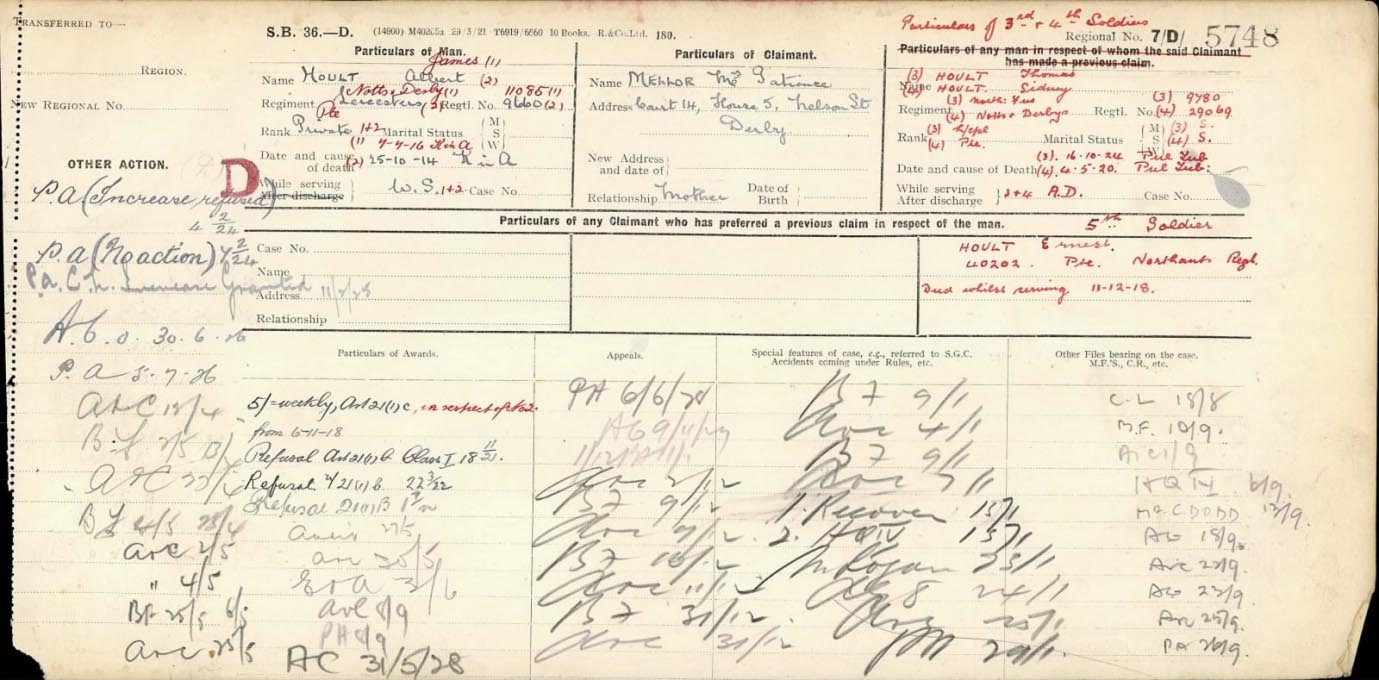
James and Albert evidently died during the war, Ernest died in December 1918, while still in service, and both Sidney and Thomas died in the early 1920s.
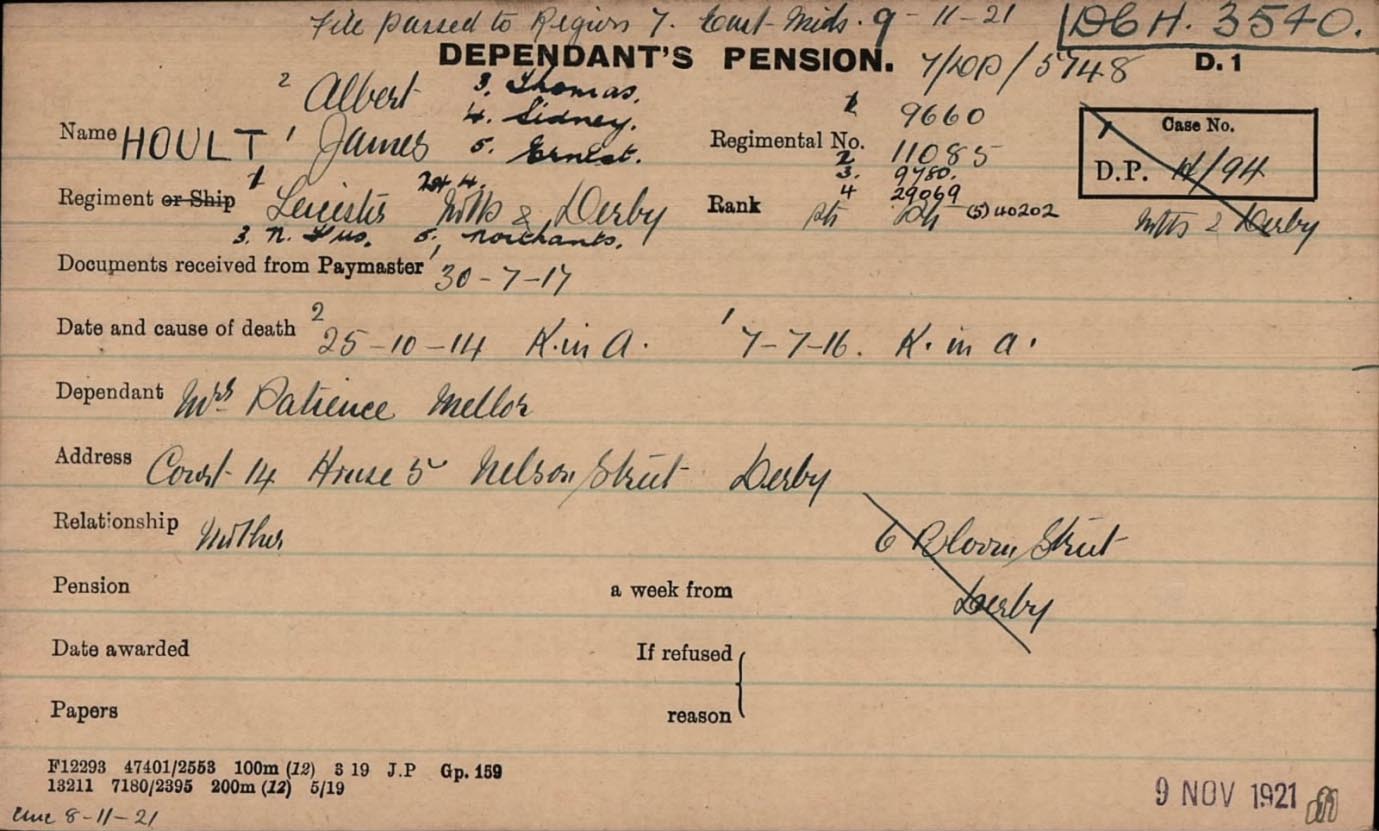
The following are brief histories of the five sons, in date order of their deaths. It is quite clear that four were definitely in the regular army or reservists, as they served overseas from soon after the war started, each being awarded the 1914 Star. The other son was the only one to be married when war broke out but still managed to qualify for the award of the 1914-5 Star, and as will be seen later, may also have been a regular soldier.
Albert Hoult
Albert served as Pte. Albert Hoult, 9660 1st Battalion Leicestershire Regiment. The battalion was recalled from Ireland when war broke out, and Albert embarked for France with the battalion on 9 September 1914, landing at St Nazaire on the following day. Unfortunately, his service record hasn’t survived.
He was killed very early in the war, on 25 October 1914, and the following events were established from the battalion war diary.
The battalion had been billeted overnight at Bois Grenier, to the South West of Armentieres, before relieving the West Yorkshire Regiment and taking over a defensive line near Rue du Bois on the evening of 21 October 1914. Battalion headquarters were established at La Houssoie railway station. The position was heavily shelled the following day, and they had to beat off attacks at dawn and in the afternoon of 23 October. A heavy attack the following afternoon caused the line to be withdrawn 200 yards to the railway line. The Germans then launched a fresh attack at dawn on the 25 October but were beaten back with heavy loss. Two platoons of the battalion were enfiladed and forced to retire in the morning before managing to regain the lost ground by dusk. The battalion lost heavily on this day, the war diary reporting the losses amongst other ranks of 22 killed, 68 wounded and 98 missing.
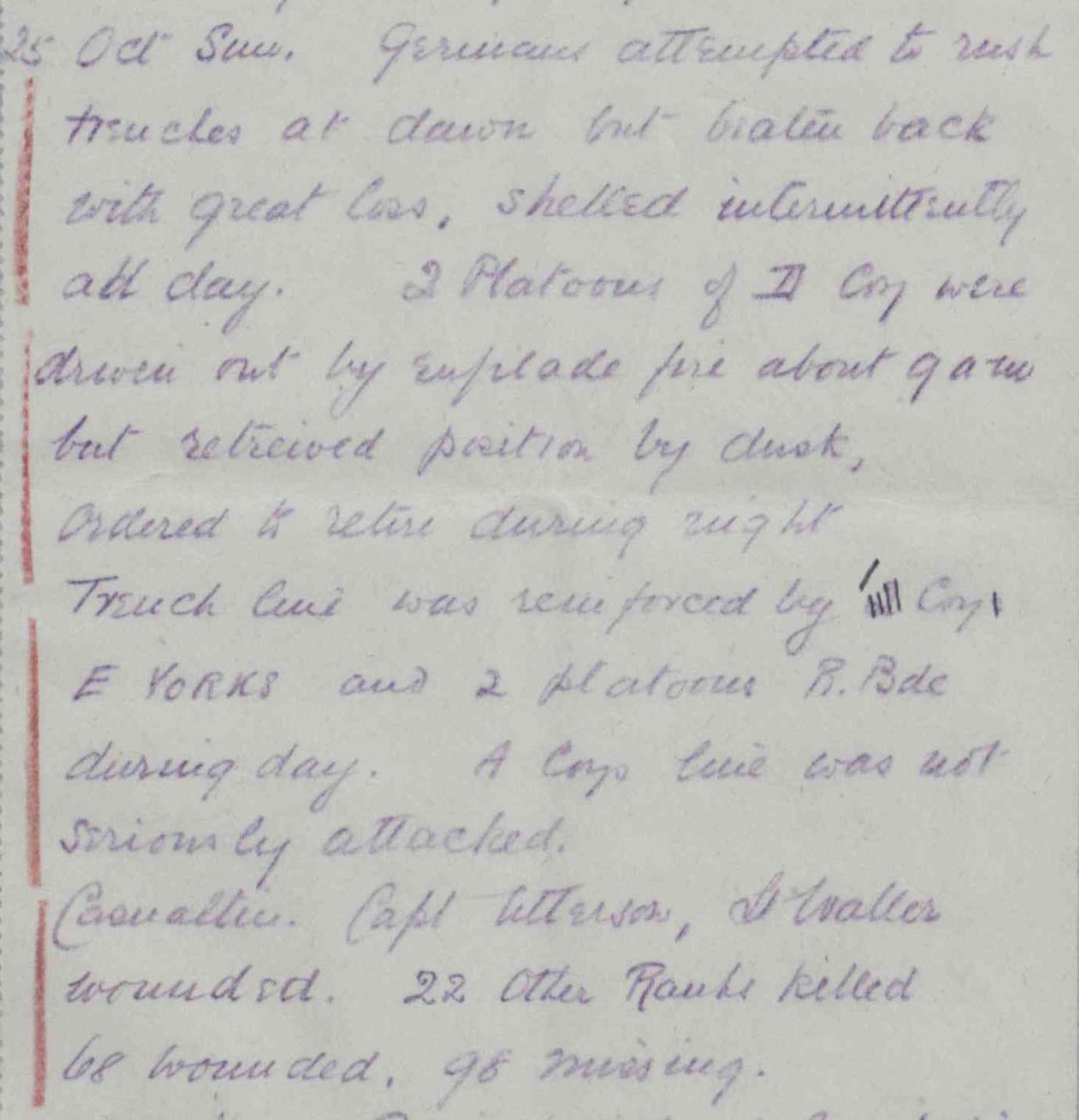
It is possible that Albert Hoult was originally considered to be among the missing, but his death was confirmed within a month, as evidenced by the following article which appeared in the Alfreton Journal of 27 November 1914.
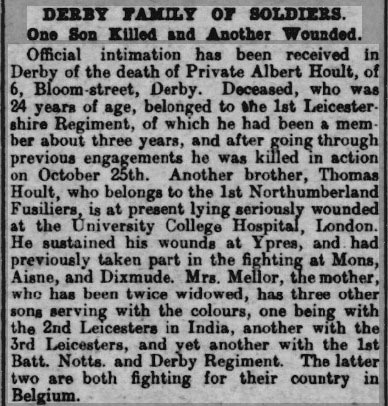
Few of the men lost on that day have a known grave, an exception being Pte. 9561 James Bostock, found in 1942 by a farmer at Ennetieres, along with an unidentified soldier of the Leicestershire Regiment, and reburied by the Germans in the local churchyard. He now lies in Canadian Cemetery No 2, Neuvelle-St Vaast.
Albert’s soldiers’ effects record has a lengthy list of recipients, comprising his mother Patience Mellor, brothers Walter, Thomas, Sidney and Ernest, sisters Emma C, Annie, Louisa and Patience, and sister in law Rebecca.
Albert Hoult’s body was buried in an isolated grave at La Houssoie, and he was identified by his disc. Exhumed on 2 April 1962, along with two unknown British soldiers, he was re-buried with them in a collective grave at Terlincthun British Cemetery, Wimille on 10 May 1962.
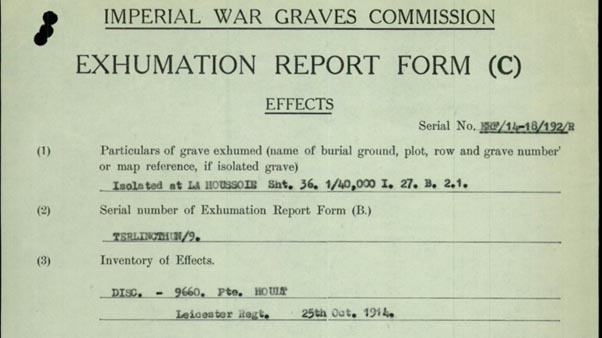
Using the map co-ordinates, the appropriate WFA trench map shows he was found close to the D63, Rue de la Gare, at La Houssoie. The railway and railway station both appear to be long gone.
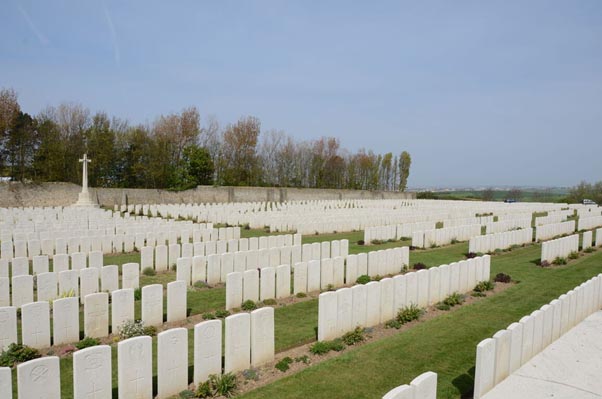
Terlincthun British Cemetery was an ‘open’ cemetery for many years, and graves that were isolated or difficult to maintain were brought in from throughout France.
James Arthur Hoult
James served as Pte. James Hoult, 11085, 1 Battalion Notts & Derby Regiment (Sherwood Foresters). The battalion had been recalled from Bombay at the outbreak of war, embarking for France on 4 November 1914. His is the only service record to have survived, being found in the ‘burnt series’ WO 363, and shows he was a labourer when he enlisted in February 1909, after joining 3 Battalion Sherwood Foresters (Special Reserve) in the previous July.
The 1911 census shows him serving with 2 Battalion Sherwood Forester, based at Crownhill Barracks, Plymouth.
The Battalion war diary indicates that 1916 found the battalion on the Somme at Dernancourt on 4 July, before taking up positions near the church at La Boiselle, and then being involved in severe fighting at close quarters on the following day, but without being able to hold any of the ground gained. The battalion returned to Dernancourt in the early hours of 6 July and rested there.
On 7 July the battalion marched to Fricourt and took up positions alongside of Fricourt Wood and Lonely Copse. The battalion moved up to Shelter Wood at 1pm, taking cover in shell holes on the edges of the wood while under heavy shell fire. At 5pm they were ordered to occupy a trench in front of the wood, which was already overcrowded, so they set to work joining up shell holes to form a new trench behind the wood. Battalion headquarters was set up in nearby Crucifix Trench, alongside a party of men who had carried bombs from Fricourt Wood. Both trench positions were under continuous shelling.
The order to withdraw to Lozenge Wood the following morning came too late for James Hoult, whose death was recorded on 7 July 1916. He has no known grave and is remembered on the Thiepval Memorial.
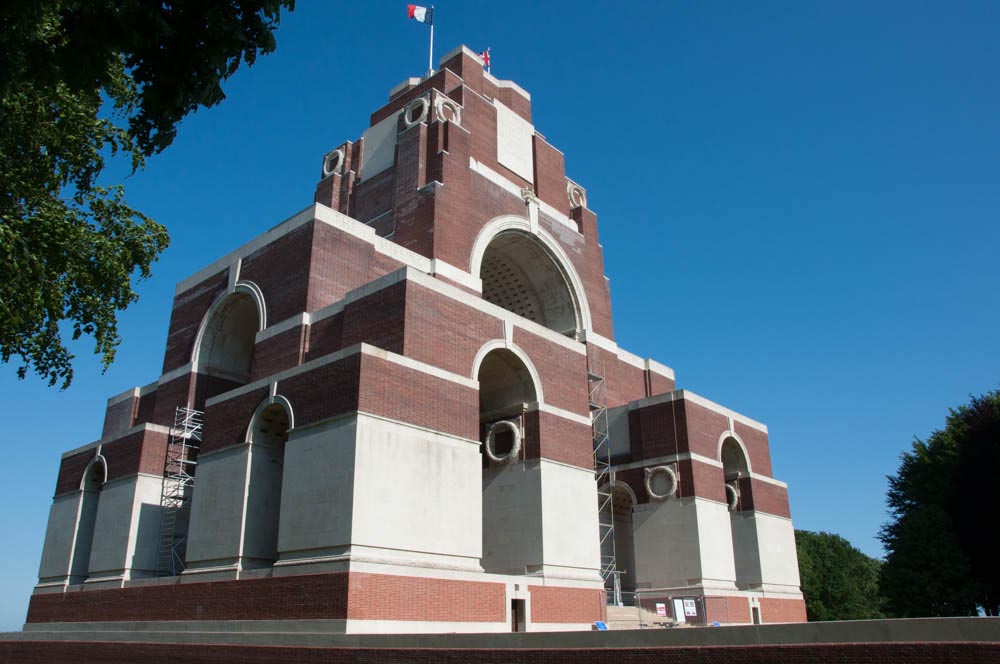
His soldiers’ effects entry records his mother, Mrs Patience Mellor, as sole legatee.
Ernest Hoult
Ernest served as Pte. Ernest Hoult, 2/9021 2 Battalion, Leicestershire Regiment, and also as Pte. 40202 2 Battalion Northamptonshire Regiment.
2 Battalion Leicestershire Regiment, a regular army unit, and part of the 7 (Meerut Division), Indian Army, were recalled from India at the outbreak of war, and landed in France on 12 October 1914 before moving to Mesopotamia in December 1915.
His medal roll entries show he first served overseas in a theatre of war when he embarked for France and Belgium on 9 March 1915, so without a surviving service record it’s not possible to ascertain whether he had returned from India with this unit, India not being classed as a theatre of war. He certainly appears not to have left for France with the first draft of 2 Battalion Leicestershire Regiment in October 1914 and was presumably in England at the beginning of March 1915. It is similarly impossible to determine when he transferred to 2 Battalion Northamptonshire Regiment.
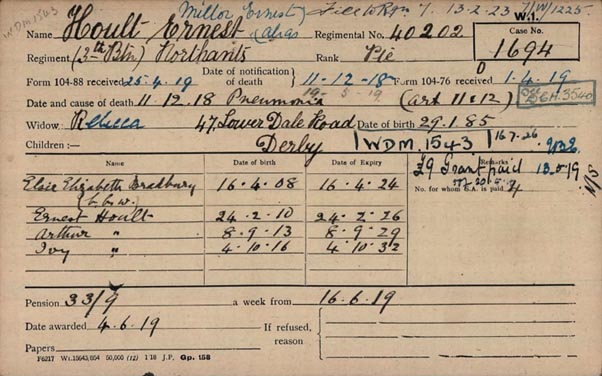
The card records the names of his wife and children. He had married Rebecca Bradbury in Derby in the second quarter of 1909. She had four children, the first being born out of wedlock in 1908. The card indicates that Ernest died of pneumonia on 11 December 1918, and CWGC notes he is buried in Derby (Nottingham Road) cemetery.
Note that the first ledger card shown, in the ‘Pension Records’ section, states that ‘Ernest died whilst serving’ so his dependant was clearly eligible for a pension.
His soldiers’ effects entry shows that he died of sickness at Sheerness, which explains why his death was registered in the Sheppey district, and it also notes his sole legatee as his widow Rebecca. He was also noted as serving with 3 Battalion (Reserve) Northamptonshire Regiment, this being based at Sheppey from May 1918.
The 1921 census shows Rebecca living with her children at 8 Corden Street, Derby. The 1939 register records her at 23 Kitchener Avenue, with son Arthur, and reveals she had a further son, Cyril, born 27 March 1922. Rebecca never remarried, and her death was registered in Derby in 1953, aged 68.
Sidney Hoult
Medal records show that he served as Pte. Sidney Hoult, 11413, 1 Battalion Leicestershire Regiment, the same battalion as his brother Albert, but embarked for overseas service on 9 November 1914, two months after Albert. He later served as Pte. 29069, 1 Battalion Sherwood Foresters, but without a surviving service record it is not possible to establish his exact period of service in either regiment.
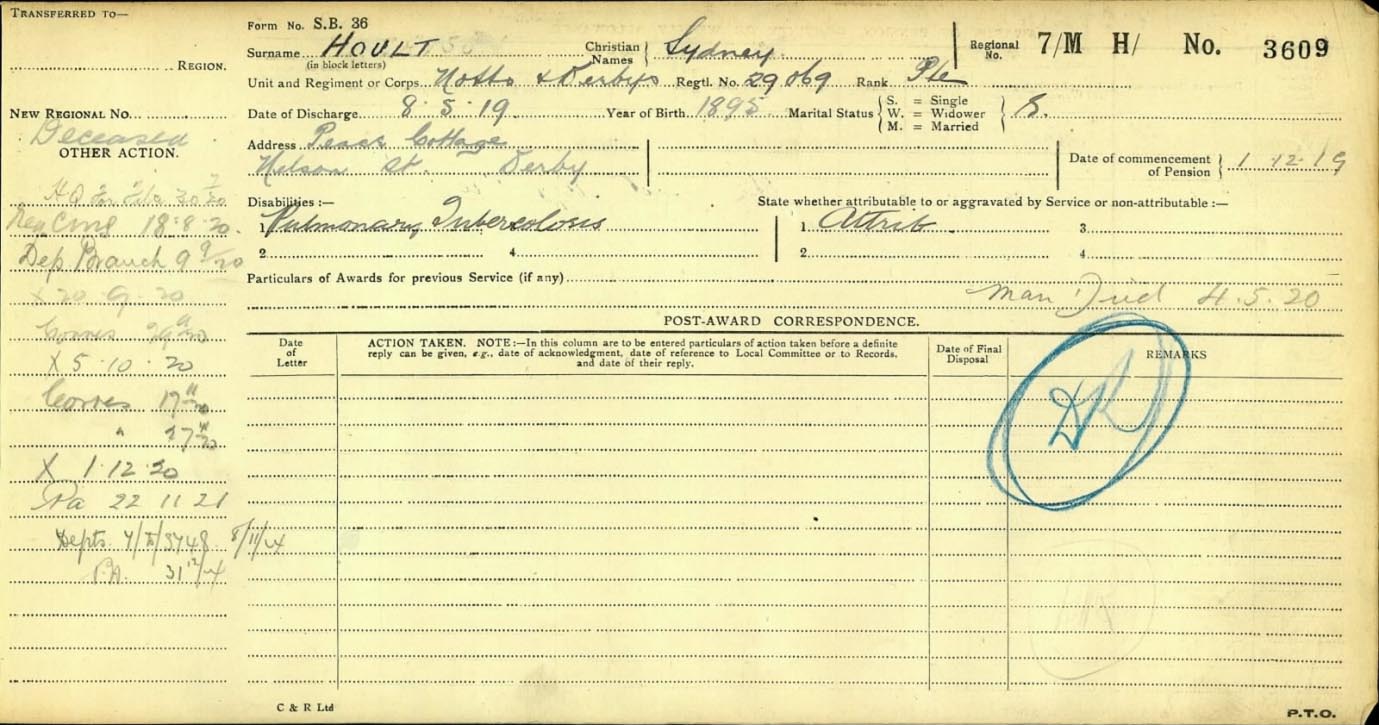
Sidney died on 4 May 1920, his death being registered in the Derby district aged 25. The death certificate confirms that he died of pulmonary tuberculosis, and shows that he had been suffering for a year and six months.

The GRO marriage register shows that Sidney Hoult married Minnie Robinson in the first quarter of 1920, so it is quite clear that our man married shortly before his untimely death. The 1921 census shows that 157 Rutland Street was occupied by the Hawling family, where a step daughter, Minnie Robinson, aged 20, has had her name amended to Minnie Hoult, and her status given as a widow. A granddaughter, Vera Hoult, aged 1 was also living at the same address in 1921, and the GRO birth register establishes that she was Vera Patience Hoult, born in the second quarter of 1920, with mother’s maiden name of Robinson, and clearly named after Sidney’s mother. His widow would not have been eligible for a widow’s pension as the marriage took place after his discharge.
Thomas Hoult
Thomas served as L/Cpl 9780, I Battalion Northumberland Fusiliers, and embarked on 13 August 1914, landing the following day at Le Havre. The newspaper article of 27 November 1914, which announced the death of his brother Albert, showed that Thomas had fought at Mons, Aisne and Dixmude, had been severely wounded at Ypres, and was currently at University College Hospital, London. The Silver War Badge roll shows he was awarded a badge (SWB) due to wounds and was discharged from the army on 14 July 1915.
In the absence of a service record, the SWB roll also proved useful in revealing that he originally enlisted on 2 October 1903. His medal index card notes that his badge was found and returned to the owner. The War Office had made it known that replacements would not be issued, but that a badge handed in to a police station would be returned to the War Office, who would then seek to return it to the recipient.
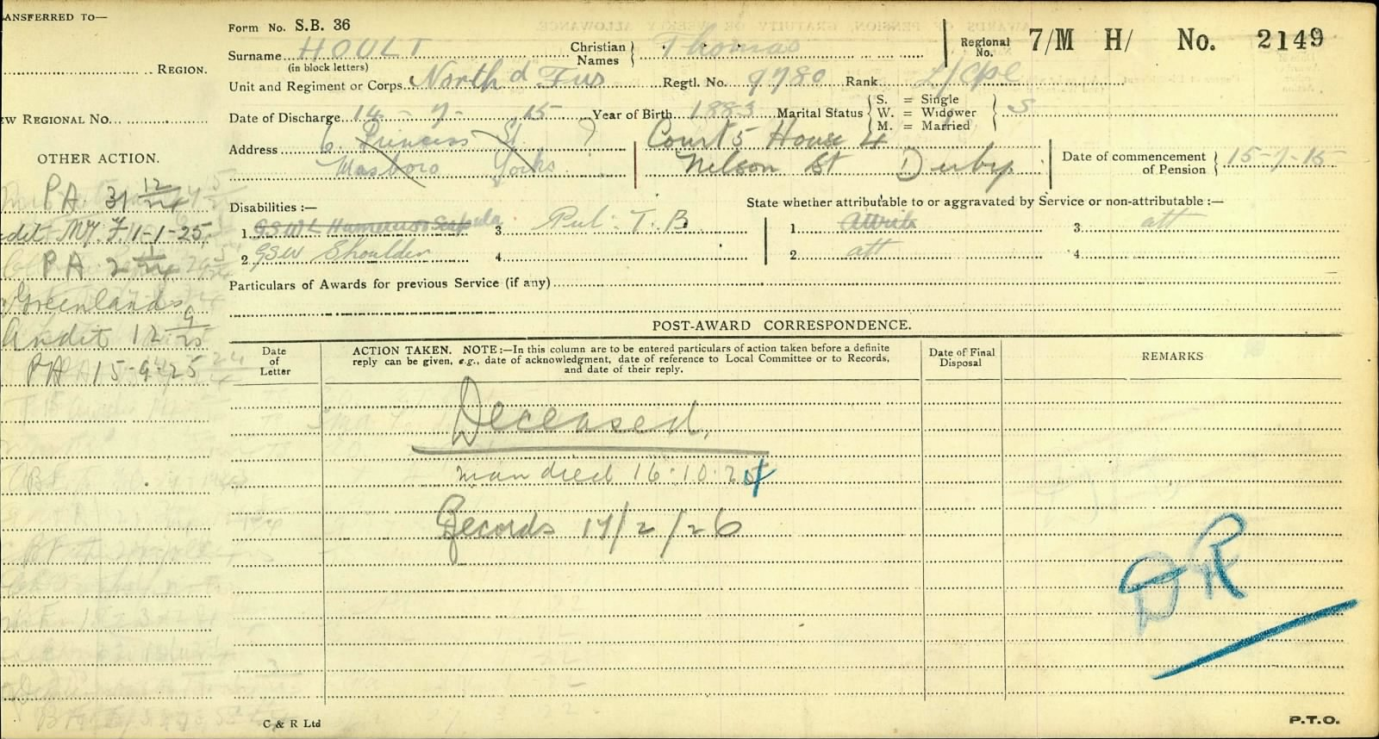
In the 1921 census Thomas was living in Derby with his mother, and described as an out of work bricklayer, with his place of work given as Masborough Sheffield, this address being the same as that crossed out on the above ledger card.
This ledger entry shows that he died on 16 October 1924. As was the case for the claim for his brother Sidney, it should be noted that the ledger card, first shown in the ‘Pension Records’ section, with his mother as claimant, gave cause of death as ‘Pul Tub, so his death was directly attributable to his army service.
His death was registered in the Birmingham South district, as he had died in City Hospital, West Heath, in the Northfield area of Birmingham on 16 October 1924, cause of death being confirmed as pulmonary tuberculosis, with accompanying haemoptysis, the latter medical term relating to coughing up blood from the lungs.

City Hospital was established in 1889 as an infectious disease hospital, but following a reduction in smallpox cases it became a dedicated tuberculosis hospital in 1910.
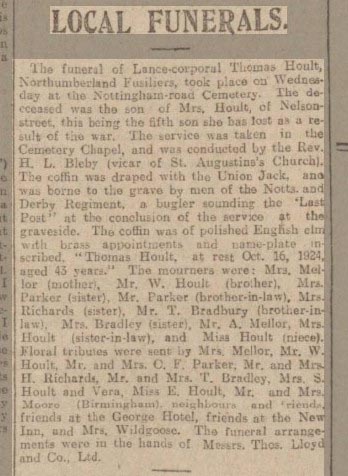
Walter Hoult
There is no evidence that Walter Hoult, the youngest son, served in the armed forces in the Great War, but in 1921 he was living with his mother and sadly, the single word ‘cripple’ is used to describe his personal occupation, and he is noted as out of work. The 1939 Register describes his occupation as a ‘general light labourer’ and he remained in Derby until his death in 1961.
Summary
Patience Hoult had a large family, was widowed in 1900 and remarried in 1903 to John Mellor, who himself died in 1911. She raised six sons, four of whom, and possibly a fifth, were regular soldiers. Five served in the Great War, the four regulars all leaving for France or Belgium in 1914, while the fifth, the only son to be married at the time, reached France in early 1915. It would appear that the sixth son may have suffered from a disability that would have prevented him from serving.
She lost two sons during the war, neither of whom had a known grave, until Albert was exhumed from an isolated grave in 1962, long after her death. She lost a third son to influenza, just after the war ended, and her fourth and fifth sons were lost to pulmonary tuberculosis, all too commonly contracted or exacerbated by the war.
According to the Royal British Legion, 55,000 soldiers returned from the war suffering from this disease, and 18,000 had died by 1922. The unsanitary, damp and crowded conditions involved with trench life were an ideal breeding ground for pulmonary tuberculosis, while exposure to mustard gas and the general harsh living conditions were thought to be responsible for reactivation of any dormant disease.
When attempting to quantify the tragic impact on Patience Mellor, it must be realised that she effectively lost five sons through the Great War, there surely being little or no distinction between losing them between the war years, or shortly afterwards from disease attributable to the war.
As an aside, Patience was shown to be an office cleaner for the Midland Railway in the 1921 census, and this would have been at Midland House, the railway’s headquarters, and situated at 1 Nelson Street, a stone’s throw from her home.
Article contributed by Dr. Alan Hawkins
Acknowledgements
Thanks are due to Gary Poucher for providing public access to the family tree of Sidney Hoult, which directly led to the invaluable discovery of the newspaper article, shown at the beginning of this article. This tree also provided awareness of Sidney’s marriage and the sad bereavement of his wife and infant daughter, which would almost certainly not have been otherwise found.
Thanks to Jill Stewart for her interest and valuable contribution to this article, which included provision of the press cuttings.
Thanks are also due to the excellent website longlongtrail.co.uk, which proved so very useful in tracing the whereabouts of various battalions through the war period.





